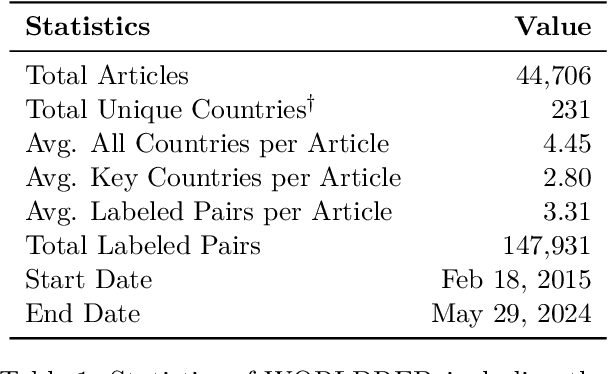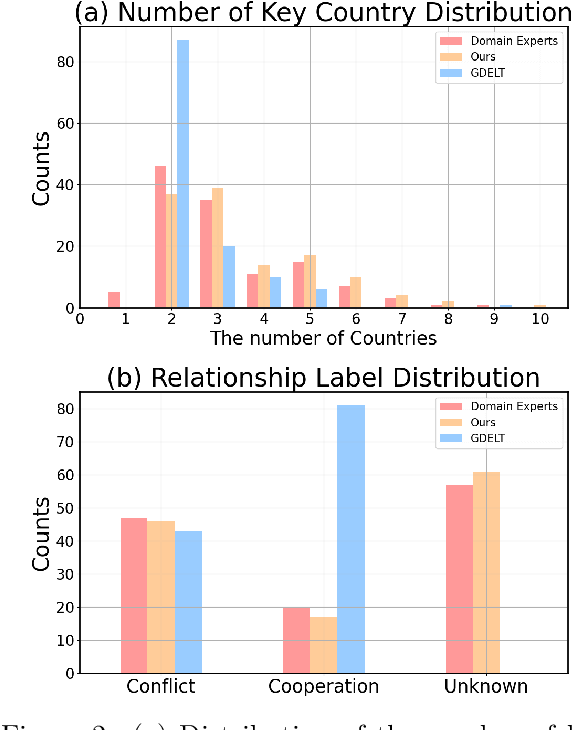Edward Choi
LabTOP: A Unified Model for Lab Test Outcome Prediction on Electronic Health Records
Feb 20, 2025Abstract:Lab tests are fundamental for diagnosing diseases and monitoring patient conditions. However, frequent testing can be burdensome for patients, and test results may not always be immediately available. To address these challenges, we propose LabTOP, a unified model that predicts lab test outcomes by leveraging a language modeling approach on EHR data. Unlike conventional methods that estimate only a subset of lab tests or classify discrete value ranges, LabTOP performs continuous numerical predictions for a diverse range of lab items. We evaluate LabTOP on three publicly available EHR datasets and demonstrate that it outperforms existing methods, including traditional machine learning models and state-of-the-art large language models. We also conduct extensive ablation studies to confirm the effectiveness of our design choices. We believe that LabTOP will serve as an accurate and generalizable framework for lab test outcome prediction, with potential applications in clinical decision support and early detection of critical conditions.
R2-KG: General-Purpose Dual-Agent Framework for Reliable Reasoning on Knowledge Graphs
Feb 18, 2025Abstract:Recent studies have combined Large Language Models (LLMs) with Knowledge Graphs (KGs) to enhance reasoning, improving inference accuracy without additional training while mitigating hallucination. However, existing frameworks are often rigid, struggling to adapt to KG or task changes. They also rely heavily on powerful LLMs for reliable (i.e., trustworthy) reasoning. To address this, We introduce R2-KG, a plug-and-play, dual-agent framework that separates reasoning into two roles: an Operator (a low-capacity LLM) that gathers evidence and a Supervisor (a high-capacity LLM) that makes final judgments. This design is cost-efficient for LLM inference while still maintaining strong reasoning accuracy. Additionally, R2-KG employs an Abstention mechanism, generating answers only when sufficient evidence is collected from KG, which significantly enhances reliability. Experiments across multiple KG-based reasoning tasks show that R2-KG consistently outperforms baselines in both accuracy and reliability, regardless of the inherent capability of LLMs used as the Operator. Further experiments reveal that the single-agent version of R2-KG, equipped with a strict self-consistency strategy, achieves significantly higher-than-baseline reliability while reducing inference cost. However, it also leads to a higher abstention rate in complex KGs. Our findings establish R2-KG as a flexible and cost-effective solution for KG-based reasoning. It reduces reliance on high-capacity LLMs while ensuring trustworthy inference.
Ensembling Large Language Models with Process Reward-Guided Tree Search for Better Complex Reasoning
Dec 20, 2024



Abstract:Despite recent advances in large language models, open-source models often struggle to consistently perform well on complex reasoning tasks. Existing ensemble methods, whether applied at the token or output levels, fail to address these challenges. In response, we present Language model Ensemble with Monte Carlo Tree Search (LE-MCTS), a novel framework for process-level ensembling of language models. LE-MCTS formulates step-by-step reasoning with an ensemble of language models as a Markov decision process. In this framework, states represent intermediate reasoning paths, while actions consist of generating the next reasoning step using one of the language models selected from a predefined pool. Guided by a process-based reward model, LE-MCTS performs a tree search over the reasoning steps generated by different language models, identifying the most accurate reasoning chain. Experimental results on five mathematical reasoning benchmarks demonstrate that our approach outperforms both single language model decoding algorithms and language model ensemble methods. Notably, LE-MCTS improves performance by 3.6% and 4.3% on the MATH and MQA datasets, respectively, highlighting its effectiveness in solving complex reasoning problems.
Forecasting Future International Events: A Reliable Dataset for Text-Based Event Modeling
Nov 21, 2024



Abstract:Predicting future international events from textual information, such as news articles, has tremendous potential for applications in global policy, strategic decision-making, and geopolitics. However, existing datasets available for this task are often limited in quality, hindering the progress of related research. In this paper, we introduce WORLDREP (WORLD Relationship and Event Prediction), a novel dataset designed to address these limitations by leveraging the advanced reasoning capabilities of large-language models (LLMs). Our dataset features high-quality scoring labels generated through advanced prompt modeling and rigorously validated by domain experts in political science. We showcase the quality and utility of WORLDREP for real-world event prediction tasks, demonstrating its effectiveness through extensive experiments and analysis. Furthermore, we publicly release our dataset along with the full automation source code for data collection, labeling, and benchmarking, aiming to support and advance research in text-based event prediction.
Single Ground Truth Is Not Enough: Add Linguistic Variability to Aspect-based Sentiment Analysis Evaluation
Oct 13, 2024



Abstract:Aspect-based sentiment analysis (ABSA) is the challenging task of extracting sentiment along with its corresponding aspects and opinions from human language. Due to the inherent variability of natural language, aspect and opinion terms can be expressed in various surface forms, making their accurate identification complex. Current evaluation methods for this task often restrict answers to a single ground truth, penalizing semantically equivalent predictions that differ in surface form. To address this limitation, we propose a novel, fully automated pipeline that augments existing test sets with alternative valid responses for aspect and opinion terms. This approach enables a fairer assessment of language models by accommodating linguistic diversity, resulting in higher human agreement than single-answer test sets (up to 10%p improvement in Kendall's Tau score). Our experimental results demonstrate that Large Language Models (LLMs) show substantial performance improvements over T5 models when evaluated using our augmented test set, suggesting that LLMs' capabilities in ABSA tasks may have been underestimated. This work contributes to a more comprehensive evaluation framework for ABSA, potentially leading to more accurate assessments of model performance in information extraction tasks, particularly those involving span extraction.
Towards Predicting Temporal Changes in a Patient's Chest X-ray Images based on Electronic Health Records
Sep 11, 2024Abstract:Chest X-ray imaging (CXR) is an important diagnostic tool used in hospitals to assess patient conditions and monitor changes over time. Generative models, specifically diffusion-based models, have shown promise in generating realistic synthetic X-rays. However, these models mainly focus on conditional generation using single-time-point data, i.e., typically CXRs taken at a specific time with their corresponding reports, limiting their clinical utility, particularly for capturing temporal changes. To address this limitation, we propose a novel framework, EHRXDiff, which predicts future CXR images by integrating previous CXRs with subsequent medical events, e.g., prescriptions, lab measures, etc. Our framework dynamically tracks and predicts disease progression based on a latent diffusion model, conditioned on the previous CXR image and a history of medical events. We comprehensively evaluate the performance of our framework across three key aspects, including clinical consistency, demographic consistency, and visual realism. We demonstrate that our framework generates high-quality, realistic future images that capture potential temporal changes, suggesting its potential for further development as a clinical simulation tool. This could offer valuable insights for patient monitoring and treatment planning in the medical field.
Time is Not Enough: Time-Frequency based Explanation for Time-Series Black-Box Models
Aug 07, 2024



Abstract:Despite the massive attention given to time-series explanations due to their extensive applications, a notable limitation in existing approaches is their primary reliance on the time-domain. This overlooks the inherent characteristic of time-series data containing both time and frequency features. In this work, we present Spectral eXplanation (SpectralX), an XAI framework that provides time-frequency explanations for time-series black-box classifiers. This easily adaptable framework enables users to "plug-in" various perturbation-based XAI methods for any pre-trained time-series classification models to assess their impact on the explanation quality without having to modify the framework architecture. Additionally, we introduce Feature Importance Approximations (FIA), a new perturbation-based XAI method. These methods consist of feature insertion, deletion, and combination techniques to enhance computational efficiency and class-specific explanations in time-series classification tasks. We conduct extensive experiments in the generated synthetic dataset and various UCR Time-Series datasets to first compare the explanation performance of FIA and other existing perturbation-based XAI methods in both time-domain and time-frequency domain, and then show the superiority of our FIA in the time-frequency domain with the SpectralX framework. Finally, we conduct a user study to confirm the practicality of our FIA in SpectralX framework for class-specific time-frequency based time-series explanations. The source code is available in https://github.com/gustmd0121/Time_is_not_Enough
EHRCon: Dataset for Checking Consistency between Unstructured Notes and Structured Tables in Electronic Health Records
Jun 24, 2024



Abstract:Electronic Health Records (EHRs) are integral for storing comprehensive patient medical records, combining structured data (e.g., medications) with detailed clinical notes (e.g., physician notes). These elements are essential for straightforward data retrieval and provide deep, contextual insights into patient care. However, they often suffer from discrepancies due to unintuitive EHR system designs and human errors, posing serious risks to patient safety. To address this, we developed EHRCon, a new dataset and task specifically designed to ensure data consistency between structured tables and unstructured notes in EHRs. EHRCon was crafted in collaboration with healthcare professionals using the MIMIC-III EHR dataset, and includes manual annotations of 3,943 entities across 105 clinical notes checked against database entries for consistency. EHRCon has two versions, one using the original MIMIC-III schema, and another using the OMOP CDM schema, in order to increase its applicability and generalizability. Furthermore, leveraging the capabilities of large language models, we introduce CheckEHR, a novel framework for verifying the consistency between clinical notes and database tables. CheckEHR utilizes an eight-stage process and shows promising results in both few-shot and zero-shot settings. The code is available at https://github.com/dustn1259/EHRCon.
DialSim: A Real-Time Simulator for Evaluating Long-Term Dialogue Understanding of Conversational Agents
Jun 19, 2024



Abstract:Recent advancements in Large Language Models (LLMs) have significantly enhanced the capabilities of conversational agents, making them applicable to various fields (e.g., education). Despite their progress, the evaluation of the agents often overlooks the complexities of real-world conversations, such as real-time interactions, multi-party dialogues, and extended contextual dependencies. To bridge this gap, we introduce DialSim, a real-time dialogue simulator. In this simulator, an agent is assigned the role of a character from popular TV shows, requiring it to respond to spontaneous questions using past dialogue information and to distinguish between known and unknown information. Key features of DialSim include evaluating the agent's ability to respond within a reasonable time limit, handling long-term multi-party dialogues, and managing adversarial settings (e.g., swap character names) to challenge the agent's reliance on pre-trained knowledge. We utilized this simulator to evaluate the latest conversational agents and analyze their limitations. Our experiments highlight both the strengths and weaknesses of these agents, providing valuable insights for future improvements in the field of conversational AI. DialSim is available at https://github.com/jiho283/Simulator.
EHR-SeqSQL : A Sequential Text-to-SQL Dataset For Interactively Exploring Electronic Health Records
May 23, 2024Abstract:In this paper, we introduce EHR-SeqSQL, a novel sequential text-to-SQL dataset for Electronic Health Record (EHR) databases. EHR-SeqSQL is designed to address critical yet underexplored aspects in text-to-SQL parsing: interactivity, compositionality, and efficiency. To the best of our knowledge, EHR-SeqSQL is not only the largest but also the first medical text-to-SQL dataset benchmark to include sequential and contextual questions. We provide a data split and the new test set designed to assess compositional generalization ability. Our experiments demonstrate the superiority of a multi-turn approach over a single-turn approach in learning compositionality. Additionally, our dataset integrates specially crafted tokens into SQL queries to improve execution efficiency. With EHR-SeqSQL, we aim to bridge the gap between practical needs and academic research in the text-to-SQL domain.
 Add to Chrome
Add to Chrome Add to Firefox
Add to Firefox Add to Edge
Add to Edge